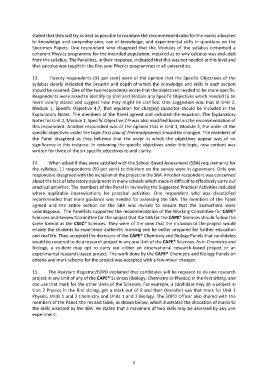Page 488 - SUBSEC October 2017_Neat
P. 488
stated that they will try as best as possible to maintain the recommended ratio for the marks allocated
to knowledge and comprehension, use of knowledge, and experimental skills in questions on the
Specimen Papers. One respondent who disagreed that the Modules of the syllabus comprised a
coherent Physics programme for the intended population, inquired as to why calculus was excluded
from the syllabus. The Panellists, in their response, indicated that this was not needed at this level and
that calculus was taught in the first year Physics programmes in all universities.
13. Twenty respondents (91 per cent) were of the opinion that the Specific Objectives of the
syllabus clearly indicated the breadth and depth of which the knowledge and skills in each section
should be covered. One of the two respondents wrote that the objectives needed to be more specific.
Respondents were asked to identify by Unit and Module any Specific Objectives which needed to be
more clearly stated and suggest how they might be clarified. One suggestion was that in Unit 2,
Module 1, Specific Objective 4.7, that equation for charging capacitor should be included in the
Explanatory Notes. The members of the Panel agreed and included the equation. The Explanatory
Notes for Unit 2, Module 1, Specific Objective 2.9 was also modified based on the recommendation of
this respondent. Another respondent was of the opinion that in Unit 1, Module 3, the order of the
specific objectives under the topic First Law of Thermodynamics should be changed. The members of
the Panel disagreed as they believed that the order in which the objectives appear was of no
significance in this instance. In reviewing the specific objectives under this topic, new content was
written for three of the six specific objectives to add clarity.
14. When asked if they were satisfied with the School-Based Assessment (SBA) requirements for
the syllabus, 11 respondents (50 per cent) to this item on the survey were in agreement. Only one
respondent disagreed with the inclusion of the project in the SBA. Another respondent was concerned
about the lack of laboratory equipment in many schools which made it difficult to effectively carry out
practical activities. The members of the Panel in reviewing the Suggested Practical Activities included
where applicable improvisations for practical activities. One respondent who was dissatisfied
recommended that more guidance was needed for assessing the SBA. The members of the Panel
agreed and the entire section on the SBA was revised to ensure that the instructions were
unambiguous. The Panellists supported the recommendation of the Working Committee for CAPE®
Sciences and Review Committee for the subject that the SBA for the CAPE® Sciences should follow the
same format as the CSEC® Sciences. They were of the view that the inclusion of the project would
enable the students to experience authentic learning and be better prepared for further education
and real life. They accepted the decisions of the CAPE® Chemistry and Biology Panels that candidates
would be required to do a research project in any one Unit of the CAPE® Sciences. As in Chemistry and
Biology, a student may opt to carry out either an observational research-based project or an
experimental research-based project. The work done by the CAPE® Chemistry and Biology Panels on
criteria and mark scheme for the project was accepted with a few minor changes.
15. The Assistant Registrar/EDPD explained that candidates will be required to do one research
project in any Unit of any of the CAPE® Sciences (Biology, Chemistry or Physics) in the first sitting, and
can use that mark for the other Units of the Sciences. For example, a candidate may do a project in
Unit 2 Physics in the first sitting, get a mark out of 9 and then (transfer) use that mark for Unit 1
Physics, Units 1 and 2 Chemistry and Units 1 and 2 Biology. The EDPD Officer also shared with the
members of the Panel, the revised table, as shown below, which illustrates the allocation of marks to
the skills assessed by the SBA. He stated that a maximum of two skills may be assessed by any one
experiment.
5

